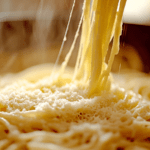Description
🍝 Discover the delicious tradition of pairing pasta with the perfect cheese for a burst of authentic Italian flavor! 🧀
✨ This recipe will transform the way you enjoy pasta, offering a savory and satisfying culinary experience! 🍽️
Ingredients
Parmigiano-Reggiano cheese
Pecorino Romano cheese
Provolone cheese
Burrata cheese
Mozzarella cheese
Fresh tomatoes
Garlic
Basil
Olive oil
Pine nuts
Butter
Pasta (spaghetti, penne, fettuccine, pappardelle, tagliatelle, etc.)
Tomato-based sauces
Ground meat (for bolognese or ragù)
Seafood (clams, squid, etc., for seafood pasta)
Heavy cream (optional for Alfredo-style)
Wild boar (optional for pappardelle al cinghiale)
Salt
Black pepper
Instructions
1. Research the history and origins of Parmesan cheese to understand its role in Italian cuisine.
2. Learn about the Protected Designation of Origin (PDO) status for authentic Parmigiano-Reggiano and its significance.
3. Identify pasta dishes where Parmesan is a must, such as tomato-based, meat-based, or cream-based recipes.
4. Explore techniques like adding Parmesan to hot pasta to melt it into the sauce.
5. Understand when to avoid Parmesan, particularly for seafood-based or herb-driven pasta dishes.
6. Highlight the cultural significance of avoiding cheese in certain Italian recipes to preserve their traditional flavors.
7. Familiarize yourself with the regional variations in cheese usage across Italy, from northern regions favoring Parmesan to southern regions emphasizing Pecorino Romano.
8. Explore the modern misunderstandings and global interpretations of Parmesan as used outside Italy.
9. Learn about the common mistakes non-Italians make, like adding Parmesan to seafood dishes or overloading pasta with cheese.
10. Address frequently asked questions about when to add Parmesan, what types of cheese Italians typically use, and specific cases like bolognese.
11. Incorporate real Parmigiano-Reggiano cheese rather than pre-shredded versions for authenticity when cooking at home.
12. Conclude by emphasizing the importance of understanding when Parmesan enhances a dish and when it’s better to skip it.
13. Use freshly grated Parmesan sparingly and with intention to elevate the flavors of your pasta dishes.
14. Respect traditional pairings and cultural norms to gain a deeper appreciation of Italian cuisine.
15. Balance flavors in each dish, allowing other ingredients to shine when Parmesan is unnecessary, particularly in seafood or herb-focused recipes.
Notes
1. Respect traditional Italian pasta pairings by knowing when Parmesan is appropriate and when it should be avoided, like in seafood dishes.
2. Always use authentic Parmigiano-Reggiano for its rich and complex flavor, and grate it fresh for the best results.
3. Understand regional Italian variations, such as choosing Pecorino Romano for dishes from central and southern Italy instead of Parmesan.
- Prep Time: 15
- Cook Time: 20
- Category: Main Course
- Method: Stovetop
- Cuisine: Italy
